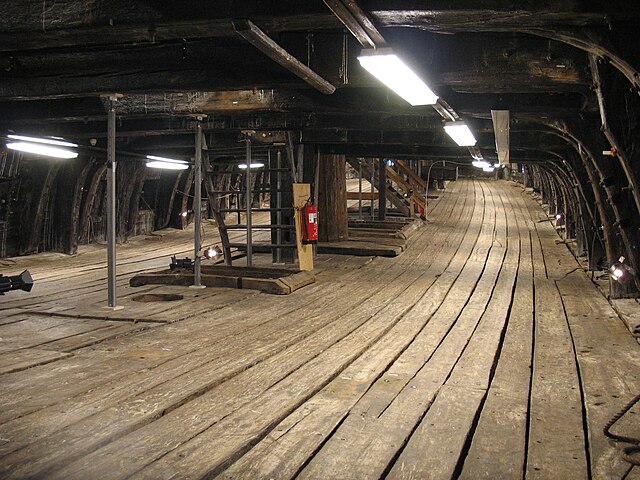Vasa or Wasa is a Swedish warship built between 1626 and 1628. The ship sank after sailing roughly 1,300 m (1,400 yd) into her maiden voyage on 10 August 1628. She fell into obscurity after most of her valuable bronze cannons were salvaged in the 17th century, until she was located again in the late 1950s in a busy shipping area in Stockholm harbor. The ship was salvaged with a largely intact hull in 1961. She was housed in a temporary museum called Wasavarvet until 1988 and then moved permanently to the Vasa Museum in the Royal National City Park in Stockholm. The ship is one of Sweden's most popular tourist attractions and has been seen by over 35 million visitors since 1961. Since her recovery, Vasa has become a widely recognized symbol of the Swedish Empire.
Vasa's port bow
Vasa's port side
A model showing a cross section of Vasa's hull, illustrating the shallow hold and two gun decks
The inside of the lower gun deck looking toward the bow. The interior of the ship does not contain any guns or any of the original contents and is currently fitted with modern lighting and other safety features.
The Vasa Museum is a maritime museum in Stockholm, Sweden. Located on the island of Djurgården, the museum displays the only almost fully intact 17th-century ship that has ever been salvaged, the 64-gun warship Vasa that sank on her maiden voyage in 1628. The Vasa Museum opened in 1990 and, according to the official website, is the most visited museum in Scandinavia. Together with other museums such as the Stockholm Maritime Museum, it belongs to the Swedish National Maritime Museums (SNMM).
Exterior of the Vasa Museum.
The main hall of the museum with a model of Vasa, complete with sails, to the left and the ship itself, which has no sails anymore, to the right.
The four floating museum ships moored outside the Vasa Museum.
Exterior detail of the museum building.








